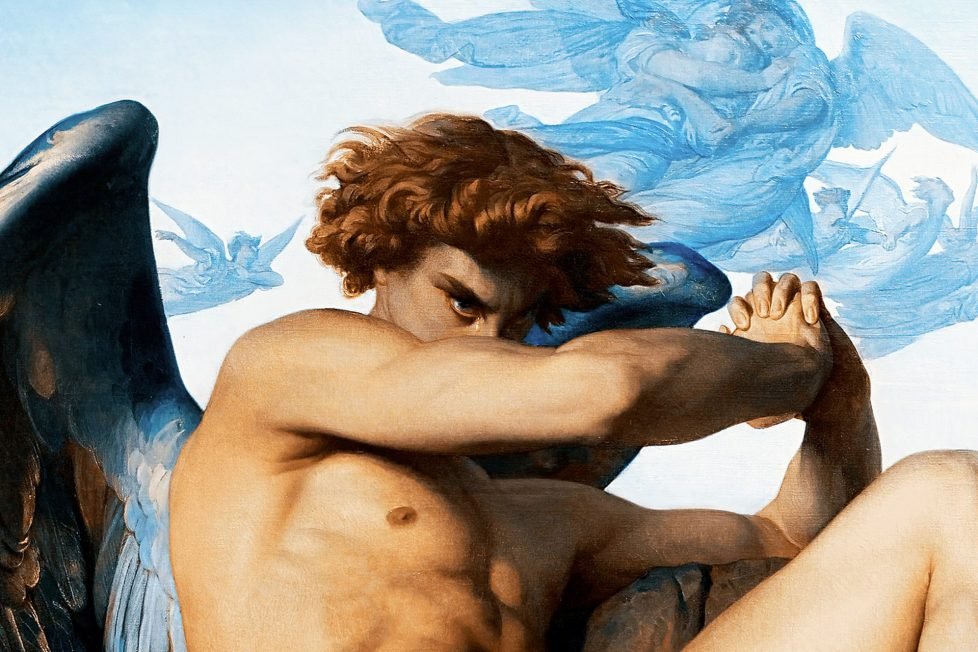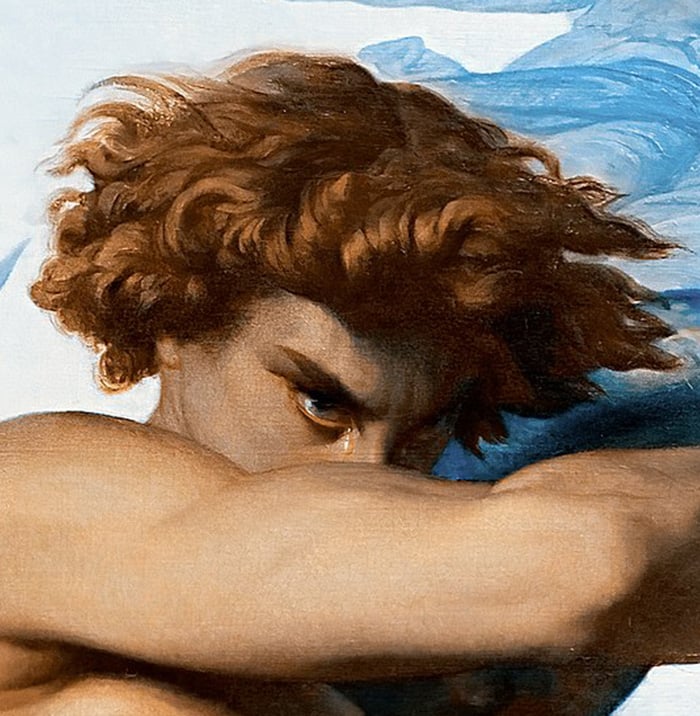Decoding “The Fallen Angel” — The Crying Lucifer Painting
The Fallen Angel is a unique portrayal of a crying, handsome devil. Lets explore its intricacies.

The Fallen Angel is a unique portrayal of a crying, handsome devil. Lets explore its intricacies.

Table of Contents
ToggleImagine standing before a life-sized painting, a remarkable sight capturing the essence of a handsome devil. This is “The Fallen Angel”, a work by the celebrated French artist, Alexandre Cabanel. Painted in 1847, it offers a depiction of a crying Lucifer following his fall from heaven. This is not your typical representation of the devil we’re all used to seeing.
Here, Lucifer is presented as a young man with a stunning physique, reminiscent of classical Roman and Greek sculptures. The artist’s portrayal of Lucifer breaks away from the standard horned demonic depiction—he instead presents a “handsome devil.”
Understanding the “The Fallen Angel” requires a look into the life and career of its creator, Alexandre Cabanel. Born in Montpellier, France in 1823, Cabanel quickly made his mark as a renowned Academic and Classical painter. It was at the young age of 24 that he painted “The Fallen Angel,” a sign of his incredible talent.
A key episode in Cabanel’s artistic development was his stay in Rome. His winning entry in the prestigious Prix de Rome scholarship afforded him the opportunity to study the classical masters in the soon to be unified Italy. This experience deeply influenced his artistic style and approach.
Cabanel’s creation of “The Fallen Angel” took place during his residency at the Villa Medici in Rome. As part of his studies, he was required to produce a male nude, which led to the initial study in 1846. After months of painstaking work, this study evolved into a detailed painting. In 1847, Cabanel further refined his composition in the final work, resulting in significant changes from the study.
Drawing from the figurative tradition of Renaissance painters, Cabanel endowed his Lucifer with a strong, toned physique. His artistry was also affected by the Romantic movement, with its emphasis on individualism, emotion, and imagination. The culmination of these influences resulted in the exquisite and emotive portrayal of Lucifer in “The Fallen Angel.”

When we take a closer look at the painting’s composition, we can see there are layers of symbolism and emotion hidden within. His folded arms, clenched hands, and covered face all hint at the shame over his downfall. Cabanel modified the original study of the painting, allowing Lucifer to peer from behind his arm instead of looking downwards.
Lucifer is the focal point of the painting, commanding the viewer’s attention with his outstretched posture and expansive wings. His right wing, prominently visible on the left side of the composition, subtly blends with the background, symbolizing his lost connection with heaven. The wingtips darken, losing their luminous whiteness, much like dead leaves ready to fall from a tree. This symbolizes Lucifer’s fall from grace and the loss of divine power.
In contrast to Lucifer’s nakedness, the angels in the sky are draped in flowing blue cloth, symbolizing their heavenly connection. Lucifer’s nudity suggests his banishment, his unworthiness of angelic garb. He leans tensely against a flat-topped rock, elevated from the surrounding terrain of a mountainous region. This careful positioning further emphasizes his isolation.
The composition of “The Fallen Angel” is a compelling visual narrative, each element contributing to the painting’s emotional depth and the story of Lucifer’s fall.

When examining Cabanel’s artistic techniques in “The Fallen Angel”, one can’t help but marvel at his mastery over color. He uses a subtle palette dominated by pastel blues and earth tones, which harmonize to depict the celestial and terrestrial realms. The soft blues, visible in Lucifer’s wings and the sky, contrast with the darker, earthy tones of the rocky terrain, symbolizing Lucifer’s fall from heaven to earth.
Lighting is another key aspect of Cabanel’s technique. He expertly manipulates light to illuminate Lucifer, casting him in sharp relief against the somewhat muted background. This creates a focal point that draws the viewer’s gaze immediately to the fallen angel. The lighting also highlights the contours of Lucifer’s physique, emphasizing his muscular form and imbuing him with an almost tangible sense of physical presence.
Texture is also worth mentioning. He gives careful attention to the texture in every element of the painting, from the detailed rendering of Lucifer’s wings and the strands of his hair, to the rugged surface of the rock upon which he leans. This attention to detail brings a sense of realism to the painting, making the scene feel immersive.
Cabanel’s use of lines and shapes is exceptional. The soft, flowing lines of Lucifer’s form and wings contrast with the hard, angular lines of the rock and the landscape, subtly reinforcing the juxtaposition between Lucifer’s former celestial existence and his harsh new reality on earth.

At the core of “The Fallen Angel” are tales of pride and punishment, deeply rooted in religious text and classical literature. Cabanel found inspiration in two influential sources: the epic poem “Paradise Lost” by John Milton and the biblical account of the War in Heaven in the Book of Revelation.
Cabanel’s painting hones in on the critical moment of Lucifer’s downfall. Once a favored angel of God, Lucifer’s pride led him to challenge God’s supremacy. Captivated by his own beauty, intelligence, and power, he coveted the honor and glory that belonged to God. This vanity and ambition triggered his downfall, marking the genesis of sin in the universe.
Classical mythology also left a significant imprint on Cabanel’s work. The depiction of Lucifer, with his perfect physique and expressive face, echoes the heroic figures of Roman and Greek myths. His defiant gaze and the tension in his posture bring to mind the classical heroes who defied the gods and suffered the consequences.

Looking into the emotional depths of “The Fallen Angel,” we are faced with a crying Lucifer. The tears streaming down Lucifer’s face signify his wounded pride and a sense of regret for being cast away from God’s angels.
However, these tears do not symbolize repentance or humility. Given the biblical context, Lucifer’s weeping can be interpreted as an expression of self-pity and resentment. Despite his banishment, Lucifer is shown in the mold of a Greek hero, embodying both physical perfection and an expressive mix of anger and rebellion.
His gaze is tragic yet dynamic, revealing a tear trembling in the corner of his eye and a lit-up pupil observing the land of his exile. These elements hint at the brewing storm within Lucifer. His flaming hair and defiant look suggest that he will not remain defeated for long—revenge is on the horizon.
Lucifer’s depiction in this painting elicits a spectrum of responses. While his courage and beauty could be seen as admirable, his arrogance and wickedness can be repulsive. Similarly, his predicament might stir sympathy in some, whereas others might find satisfaction in his divine punishment. This contrast makes the painting a mirror, reflecting the viewer’s perspectives on good and evil, free will and fate, and the repercussions of choices.

Despite being rooted in its mythic and religious contexts, “The Fallen Angel” speaks a universal language. It is a language of ambition and downfall, of pride and punishment, of rebellion and remorse. The painting is a demonstration of Cabanel’s talents, his ability to blend classical techniques with Romantic individualism, crafting a work that continues to resonate with viewers.
